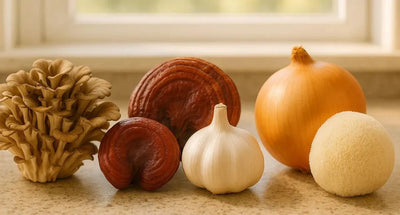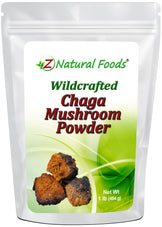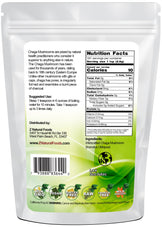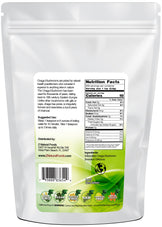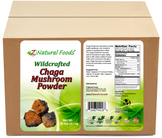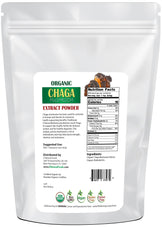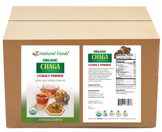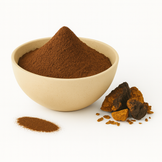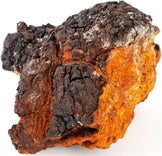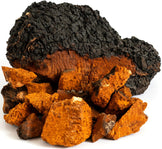Description
Description
The use of natural remedies has increased in the past few years, with individuals seeking conventional healing practices for maximum health. One remedy that has gained popularity among health enthusiasts and researchers is Chaga, a medicinal mushroom renowned for boosting immunity and overall well-being. Typically found on birch trees in the frozen woods of Siberia and Canada, chaga has been used for many years in traditional folk medicine.
Boost your health naturally with Organic Chaga Mushroom Extract Powder—shop now at Z Natural Foods!

What Is Chaga?
Chaga (Inonotus obliquus) is a fungus that infects and grows mainly on birch trees in cold regions such as Siberia, Canada, and Northern Europe. It is easily recognized by its hard, black, crusty surface, which is dark and similar to charcoal or burned wood. Notwithstanding its hard appearance, Chaga has extraordinary healing powers, which have been harnessed by traditional medicine for many centuries.
Raw Chaga is dense and wood-like and not easily ingested. It can be dried, powdered, or made into tea to utilize its health benefits. Chaga has gained popularity over the years for its ability to address diseases such as cancer, diabetes, and inflammation. It is commonly referred to as an adaptogen, a natural element thought to assist the body in coping with stress and achieving balance.
Nutritional Content And Health Benefits Of Chaga
Chaga mushrooms are rich in nutritional compounds that are responsible for the health benefits associated with them. Some of these include:
- Polysaccharides: Chaga's polysaccharides stimulate white blood cell production, vital in the body's immune response. These properties make Chaga a strong natural supplement for immune system support.
- Beta-Glucans Are a soluble fiber that controls blood sugar levels and benefits cardiovascular health. Chaga's beta-glucans are especially useful for individuals with diabetes.
- Antioxidants: Chaga contains antioxidants like superoxide dismutase (SOD), which fight free radicals within the body. By disarming free radicals, Chaga may lower oxidative stress, a primary contributor to aging and the onset of chronic diseases such as cancer.
- Triterpenoids: These substances are responsible for Chaga's anti-inflammatory and anti-cancer effects. In certain research, triterpenoids have been identified to induce normal cell growth and inhibit the growth of cancer cells.
- Vitamins and Minerals: Chaga contains vitamins (such as B-complex and vitamin D) and minerals (including zinc, magnesium, and potassium) that help with general health and well-being.
The Healing Power Behind Chaga Mushrooms
Mushrooms contain a wide range of non-starch polysaccharides (carbohydrate fractions excluding starch and free sugar) like;
- chitin,
- beta-glucans,
- alpha-glucans,
- hemicellulose,
- mannans,
- xylans, and
- galactan's.
Non-starch polysaccharides are distinguished into soluble and insoluble fractions, with up to 90% being insoluble fractions. Most (around 80%) of insoluble polysaccharides are chitin, including beta-glucans bound onto chitin or protein.
Polysaccharides can support a wide range of actions in the human body.
Polysaccharides have been shown to have;
- immunological,
- neurogenic,
- cardiovascular, and
- Microbiome effects and
- a host of other nourishing qualities.
It is believed that the primary polysaccharides found in fungi are beta-D-glucans, which come in various forms (beta 1-3 and 1-6) and are specific to fungi and yeast.
Other polysaccharides found in mushrooms are Alpha-glucans, such as glycogen, dextran, pullulan, and starch, which are not thought to provide the same nourishing qualities as beta-glucans.
This belief tells you only part of the story and may be based on flawed science.
You may have noticed that most medicinal mushroom product labels focus only on beta-glucan levels; therefore, some important points must be clarified.
Facts about beta-glucans
- And why not all medicinal mushrooms are the same
- Beta-glucans are a classification of compounds known as polymers.
- There are hundreds of beta-glucan shapes and sizes, and while some are biologically active, others are not. Furthermore, not all are immunologically active.
- Each species of fungi may contain a different beta-glucan.
- Beta-glucans can differ in function, solubility, and interaction with other molecules.
- While beta-glucans are potent compounds, they are just one variable of a wide range of compounds responsible for a mushroom's many nourishing qualities.
- Ultimately, Beta-glucan levels are not necessarily the telltale sign of a product's effectiveness.
Changa As Immune System Support
One of Chaga's most well-known advantages is its potential to boost immune function. Studies have established that the polysaccharides and beta-glucans in Chaga mushrooms can stimulate the immune system, enabling the body to protect itself from invaders. Chaga has also been found to modulate the immune system by stimulating or suppressing immune responses based on what the body requires. This makes it a versatile treatment for many immune-related ailments.
One of the most important aspects of Chaga's immune system-boosting abilities is its ability to combat inflammation. Long-term inflammation is usually associated with a range of health problems, such as autoimmune disorders, heart disease, and even cancer. By suppressing inflammation, Chaga can potentially prevent the development of these diseases and ensure overall wellness.
Chaga as a Possible Cancer Cure
Although additional research is required, initial studies have been promising as a possible complementary therapy for cancer. Certain studies have indicated that chaga mushrooms have compounds that can potentially inhibit the growth of cancer cells and slow the spread of tumors. This is largely due to the content of antioxidants, namely melanin, which is recognized to have anti-cancer properties.
In experimental setups, chaga extracts have been used to cause apoptosis (cell death) in specific cancer cells. While chaga can be added to standard cancer treatment, it must not substitute medical intervention.
Chaga for Diabetes Control
Chaga could be of tremendous value to diabetics. The beta-glucans present in Chaga have been found to assist in maintaining balanced blood sugar levels, which is ideal for diabetes control. Through enhanced insulin sensitivity and minimal blood sugar spikes, Chaga can be an excellent inclusion in a diabetes control regimen.
Additionally, chaga's anti-inflammatory activity can assist in treating diabetes-related complications like neuropathy and cardiovascular disease. With increased research, the possibility of Chaga acting as a natural drug for diabetes control is gaining prominence.
Chaga's Adaptogenic Properties
Chaga is commonly referred to as an adaptogen, which assists the body in adapting to physical, emotional, and environmental stress. Adaptogens are natural products that help balance the body's functions and enhance overall health. Chaga's adaptogenic effects help balance the adrenal glands, which regulate the release of stress hormones such as cortisol.
By regulating the body's stress response, Chaga can help lessen feelings of anxiety, boost energy levels, and improve overall mental clarity. Many individuals discover that adding Chaga to their daily routine allows them to cope with stress more effectively and feel more centered throughout the day.
How To Use Chaga
There are several ways to add Chaga to your daily health regimen. The most common types of Chaga are:
- Chaga Tea: The simplest and most pleasant way to take chaga is to steep it as a tea. Chaga tea tastes rich and earthy and can be served hot or cold. To make Chaga tea, heat dried chunks or powder of Chaga in water for 30 minutes.
- Chaga Tincture: Chaga tinctures are superconcentrated extracts that can be consumed by putting a few drops under the tongue or mixing them with a drink. Tinctures are an excellent choice for those who want a more convenient, high-dose form of Chaga.
- Chaga Powder: Chaga mushroom powder can be added to smoothie soups or sprinkled on food. Incorporating Chaga into your diet is easy if you dislike tea or tinctures.
- Chaga Supplements: Chaga is also available in capsule or tablet form, making it easy to take on the go. Supplements are a good option for individuals who want to benefit from Chaga’s nutrients without needing preparation.
The Science Behind How Chaga Mushroom Works in the Body
According to preliminary studies, chaga’s mechanisms of action show great potential for supporting a healthy immune system. The following was stated in a report looking at the anti-inflammatory effects of Chaga Mushrooms.
- Chaga inhibited NO production and downregulated TNF-α, IL-6, and IL-1β in RAW 264.7 macrophages.
- ASE1 (novel, optimized ethanol/water extraction) and P6 (six-minute steeping of powder in 100 °C water) extracts showed the highest inhibitory activity on NO production and the expression of the inflammatory cytokines compared to extracts obtained by conventional extraction methods.
Furthermore, according to the Slone Kettering Center, the immunomodulating effects are attributed to Th1/Th2 cytokine secretion in immune cells and regulation of antigen-specific antibody production.
Frequently Asked Questions
What are the key health advantages of Chaga?
Chaga is renowned for its immune stimulation, antioxidant status, and anti-inflammatory action. It can maintain overall health by enhancing immune function and blood sugar level control and possibly supporting anti-cancer protection.
How can I incorporate Chaga into my routine?
Chaga can be taken in several ways, such as tea, tincture, or powder. You can steep it into a tasty tea, take a tincture, or add Chaga powder to foods and smoothies.
Is there scientific research backing the health benefits of Chaga?
Many studies have demonstrated that Chaga is rich in compounds that can enhance immune function, suppress inflammation, and even treat cancer. Further research is necessary to comprehend fully its therapeutic actions.
For more information about our Chaga Mushroom Powder (Wildcrafted), go here:
Chaga Mushroom Powder (Wildcrafted)
For more information about our Organic Chaga Mushroom Extract Powder, go here:
Organic Chaga Mushroom Extract Powder
To review all of our Mushroom Powders, go here:
The Author’s Bio
Michael Stuchiner is a Master Herbalist and proud graduate of The School of Natural Healing and has worked in different areas of this field for over 25 years. He is a retired elite-level powerlifter who competed for 27 years. As an avid international traveler, he is passionate about medicinal and tonic herbs and foods traditionally found in local markets in the 35 countries he has visited. Michael brings you his years of experience as a Master Herbalist, traveler, and athlete through the hundreds of articles he has written and his YouTube channel (A Master Herbalist Perspective). He is considered a true educator in this field. For more articles written by Mike, go here: Master Herbalist.

